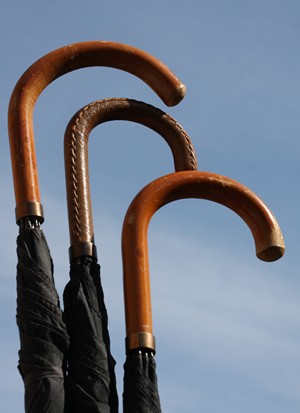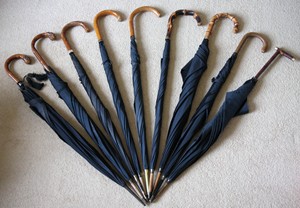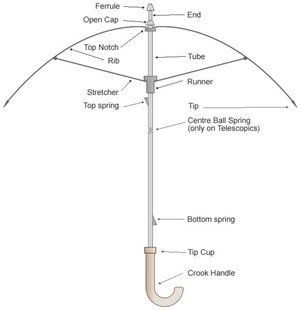Vintage umbrellas: The definitive history and collectors' guide

Umbrella history
The umbrella's origins were in ancient civilisations, but it first came to England in the eighteenth century. Both the French and Italians were converted to umbrellas before the British.
The well-travelled merchant, Jonas Hanway, was the first man to regularly use an umbrella in London. He was jeered at and pelted with rubbish by coachmen and street urchins in their pay. The coachmen saw the umbrella as a threat to their livelihood. Gentlemen hailed a cab when it rained, they did not need umbrellas. Nevertheless, others picked up the habit and the brolly became a common sight in London.
Umbrella making began as a trade in London in the late eighteenth century. Despite the novelty of the umbrella, it was not a good business. The Times reported the bankruptcy of Edward Clode of Newgate Street, London and a creditors' meeting for Daniel Worton of Gerrard Street.
Others did better. W & J Sangster was making and selling umbrellas and walking sticks from 94 Fleet Street, London in 1833. By 1854 Sangsters had premises at 140 Regent Stree, 10 Royal Exchange and 75 Cheapside, as well as the original shop in Fleet Street. The firm was still in business in 1923.
Some early pioneers survive to this day. James Smith started in business in 1830 at Fourbert Place, London making and selling umbrellas. The shop is now at 53 New Oxford Street in London. Thomas Brigg also started making and selling umbrellas around this time. Today Swaine, Adeney and Brigg is still the most prestigious umbrella retailer. The current business was formed in 1943 when, at the suggestion of the Wartime Government, Brigg Umbrellas merged with Swaine and Adeney which sold exclusive leather goods.
A full-sized umbrella from the eighteenth century had the same form as an umbrella today. However, it was heavier and bulkier. It rolled less well. Even in the early nineteenth century it was common to carry an umbrella over the shoulder.
The first umbrellas used cane or whalebone ribs. What made something approaching a usable umbrella was the introduction of steel ribs.
Henry Holland of Birmingham was the first to make a steel umbrella frame. He did this in 1840 with a frame made from steel tubing.
Holland's design was bettered by that of Samuel Fox. Fox's original design used solid ribs, but he later moved to U-shaped ribs. It was these that allowed for a more compact umbrella. The Fox frame remained the standard for a quality umbrella from 1852 to the 1980s.

As well as the frame, the most important parts of the umbrella were the canopy and the handle.
The best canopies were made from silk. Coloured designs in brown or green were common for early nineteenth century umbrellas.
Cheaper umbrellas were covered with cotton. Alpaca, originally a mixture of alpaca wool and silk, was better than cotton, but cheaper than silk. Alpaca eventually became a wool and silk mix. There were also silk and cotton mixes.
In the 1950s nylon was first used for umbrellas. It replaced silk as the most suitable material. Some traditionalists still preferred silk, although nylon was better and cheaper.
The handle was the personal part of the umbrella. Handles varied with fashion over the years. By the twentieth century the simple hook was accepted as the most practical. Although knobs, crosses, crutches, crooks and leather straps were all tried. Some handles were elaborately carved. The dandy Beau Brummell had a handle carved into a caraciture or George IV.
The trend in handles was for less elaborate ones as time went by. Simple hooks were the most common design by the 1950s.
Umbrellas were sometimes decorated with gold and silver bands. If they were hallmarked this can tell us precisely the age of the umbrella.
Men's and women's umbrellas
Although some early male umbrella users favoured coloured umbrellas, most men's umbrellas from the twentieth century were black. They tended to be walking stick-sized and conservative in design. As late as the 1950s a man's umbrella was a companion for life. Most men bought only one or two in their lifetime.
Women tended to change umbrellas more often. Women's umbrellas followed fashion closely. A woman's vintage umbrella will have a smaller canopy than a man's umbrella. Its canopy might be coloured or decorated. It may have a standard hook-type handle, but can have a stub handle with a strap attached or other fancy types of handle.
Anatomy of a vintage umbrella

The parts of a vintage umbrella are:
- Ferrule - usually brass or other metal.
- End - usually wood varnished or painted
- Open cap - same material as ferrule
- Top notch
- Tube - this can be wood or metal. It is usually steel or a solid cane which includes the handle on a vintage umbrella
- The frame comprises ribs and stretchers. It is usually spring steel (think of a clock spring), or stainless steel on later 1960s examples.
- Runner - this is brass on older umbrellas. On later umbrellas it can be plastic. Plastic runners often need replacing as they wear they don't engage the top spring correctly
- Tip cup - this is often decorative, sometimes gold plated
- Handle (crook illustrated) - often cane or sometimes leather covered
Vintage umbrella handles
Many different types of handle have been used on umbrellas: wooden handles, bone handles cane handles ivory handles, Lucite handles and many more. Some were carved into the shape of the head of a bird or an animal.
By far the most popular type of handle for men's umbrellas was the hook or the crook. By far the most common materials were polished Malacca or Whangee, a form of Japanese bamboo with a knurled look.
In the 1930s men could choose from a vast array of handles, some simple, some fancy. In the 1950s, the handles were mostly polished Malacca or Whangee.
A more modern look that was catching on in the late 1950s was the leather or pigskin handle.
Simpson of Piccadilly offered nylon-covered umbrellas with a calfskin handle for £6 5s in 1961. They offered the complete city gent package: bowler hat, leather gloves, briefcase and umbrella.
Umbrella frames
Umbrella frames were almost always made by a different company to the maker of the finished umbrella.
By the 1960s only three firms made umbrella frames in the UK: S Fox & Co, William Hoyland & Co and the Empire Rib Company. All three were based in Sheffield and used Sheffield steel.
Hoyland had links to Fox. William Hoyland and Joseph Hayward were both employed by S Fox & Sons in 1875. Hayward invented a self-closing umbrella called the 'Flexus'. Fox decided not to manufacture it and Hoyland and Hayward then established William Hoyland and Co.
The Empire Rib Company was by far the largest of the three firms. In 1964 it supplied 80% of all UK umbrellas, including all umbrellas sold by Marks and Spencer.
Fox frames were the best. It was quite common for retailers to advertise 'Fox frame' rather than the brand name of the umbrella maker.
Umbrella v parasol
An umbrella is designed to keep you dry in the rain. A parasol is meant to keep the sun off your face. Parasols were used by women. Both sexes used umbrellas.
Since umbrellas and parasols were similar you could buy one to do both jobs. It was called an 'en tout cas' (in any case).
A sun umbrella is usually a much larger static umbrella designed to provide shade. They are common in pub gardens.
Vintage umbrella - guide
Victorian umbrellas

Few umbrellas with cane or whalebone ribs have survived. Umbrellas were quite expensive and often got passed on through the secondhand market via retailers and street traders as more fashionable designs came along. An old umbrella was a symbol of a struggling clerk. They may have been repaired many times before being discarded.
It is still possible to buy umbrellas made in the Victorian era. Most will have a metal frame and the better ones a frame by Samuel Fox.
They may be difficult to date exactly, but hallmarked gold or silver bands can provide a good guide.
Edwardian umbrellas
The Army and Navy Stores' catalogue offered a huge range of umbrellas in 1907. For women there was a choice of thirty different styles. All had 23-inch frames. The handles were:
- Hooks - 10
- Crutches - 11
- Carved duck's head - 3
- Ball - 6
Materials were partridge cane, green horn, silver, ebony or tortoiseshell veneer. Many were decorated with gold or silver bands. Most also had a tassel attached.
For men there was a choice of sixteen styles all on 26-inch frames: 7 hooks, 3 straight with silver or gilt top, 4 crutches and 2 pimento roots. Materials were partridge cane, tortoiseshell veneer, horn or ivory.
The stem of the umbrella could be a steel tube or a wooden cane.
With such a range of styles it is difficult to put a definite date on the umbrellas. Hallmarked gold or silver decorations are the best guide.
Interwar umbrellas

By the 1930s most men's umbrellas were hook style. There was a choice of material: partridge, Malacca, pimento, ivory, leather, pigskin, shagreen (shark skin) or horn.
Tassels disappeared from men's umbrellas by the 1930s.
Natural cane handles were popular on 1920s' and 1930s' umbrellas. They could use a naturally forked branch or a bamboo root.
Women's umbrellas were also mostly of the hook type. They often had longer handles than men's. They were sometimes decorated with a tassel.
The alternative for women was the chubby umbrella. This was a shorter umbrella. It could have a hook handle, but more often had a straight handle with a strap through it to carry the umbrella. Sometimes chubbies had carved animal heads, dogs were popular.
Mid-century umbrellas
The biggest development in post-war umbrella making was the nylon canopy. It was superior and cheaper than silk and eventually became the only fabric used.
The trend in simpler-looking umbrellas and less choice of handle continued after the Second World War. In the 1950s and 1960s most men's umbrellas had Malacca, Whangee or leather handles.
There was more choice for women and more fashionable colours. A good guide to women's umbrellas is to look at the style of the canopy fabric. If it was not plain, it followed contemporary fashions.
Folding and telescopic umbrellas

The miniature telescopic umbrella as we know today was invented by German Hans Haupt. He patented the first successful design in 1930. The brand was called Knirps, meaning little guy.
In Europe the folding umbrella was gaining currency before the Second World War. In the UK it took much longer to catch on.
The first company to sell telescopic umbrellas in Britain was Growy. They marketed two styles. One with a hook type handle for men and one with a strap for women.
They were a tiny market in the 1960s but became much more popular in the 1970s and 1980s.
Collectors' information
How old is my vintage umbrella?
Umbrellas are not great survivors. They were used in all weathers. They were put away damp. Their canopies rotted. Their frames rusted. They were blown inside out. Ribs and stretchers snapped in violent storms. Umbrellas had a hard life.
Nevertheless, old umbrellas were faithful companions and some owners looked after them well.
That's not to say after a lifetime of use they were passed on to the next generation. Who wants an old umbrella?
Few vintage umbrellas survive and most of those that do are from the twentieth century and most of those are from the 1960s onwards.
So how do I tell the age of my old umbrella?
First decide whether it is a man's or woman's umbrella. Men's umbrellas had longer ribs 25-26 inches. Women's umbrellas were smaller with 23-inch ribs. The total length of the umbrella from the top of the handle to the tip could be the same for both sexes. This meant women's umbrellas had longer handles.
Then look at it part by part.
Deocarative band or other precious metal
Does the umbrella have a gold or silver band or other decoration with a hallmark? If yes, then this is the most reliable way to date the umbrella.
If you have a date from a hallmark this is probably the date of the umbrella, but look for other clues too, as the band could have been added later. Also an earlier band could have been added to a more modern umbrella
Handle
What type of handle does it have? Post-war umbrellas had much plainer handles. They were either plain Malacca, Whangee or leather-covered. Womens umbrellas may have had some sort of plastic handle such as Lucite or Perspex with a strap.
Pre-war umbrellas tended to be more natural looking. Post-war umbrellas looked modern and slick.
Frame
Does it have a steel frame? They were usually painted black. On most there is some evidence of rust.
If yes, then it is after 1840. If no, umbrellas with cane or whalebone ribs could be older, but are extremely rare.
Is there a name on the frame? After 1865 Samuel Fox used to put a label on the frame with his name and the 'Paragon' trademark. If you see S Fox & Co Ltd and 'Paragon' you know the umbrella was made between 1865 and 1970. If it says 'Fox Frames Ltd' it was made after 1970.
Canopy
Nylon was not used until the 1950s. For older umbrellas silk was used on the better ones and cotton on the cheaper.
How much is my umbrella worth?
Umbrellas are not as collectable as walking sticks. However, a well-made vintage umbrella in good condition can command a high price.
- Thomas Brigg umbrella - £100+
- Umbrella with Fox frame - £50 to £100
- Other umbrella in good order - around £25
As umbrellas are not that valuable you can afford to be picky. Don't buy ones with damaged canopies unless you are good with a sewing machine and plan to replace it. Avoid damaged ribs, or umbrellas with broken or missing parts.
Where to buy a vintage umbrella?
Vintage fairs are good for finding bargains. I picked up a Fox framed umbrella for just £5 recently.
eBay is also good.
Where to sell a vintage umbrella?
If you have a good clean vintage umbrella, eBay is the best price. Be honest with the description, take lots of photos and offer it with 'Buy-it-now'.
Umbrellas don't fetch much at general auctions.
By Steven Braggs, August 2022


Comments
Thank you very interesting,
I have a Jonesella Fox Frame, Paragon.
IT is brand new and still has the labels and original plastic cover.
IT is engraved Tennis Doubles K M Floyd Dum -Dum March 1921.
The rib is 20"
The handle is some sort of metal and highly decorated.
It has a woman in long clothing by a hut and palm trees & man carrying a bundle on his head
Thank you for the information
so from your information